Cardiovascular disease
Cardiovascular disease is a major cause of ill-health and death in Wales and is a priority area for the Welsh Government and NHS Wales. These web pages on cardiovascular disease contain information on risk factors, Wales data, international data comparisons and additional resources.
A set of cardiovascular disease indicators (including local authority level data) has been developed and, together with related documents, is published under file downloads. A selection of the cardiovascular disease indicators is also shown in the interactive health board map above. For definitions used please see the technical guide.
Key Messages
Risk factors
Cardiovascular disease (CVD) is largely caused by risk factors that can be controlled, treated or modified such as high blood pressure and cholesterol levels (modifiable risk factors). Some risk factors such as age and sex, however, cannot be controlled (non-modifiable risk factors).
These major risk factors increase the likelihood of developing CVD such as coronary heart disease and stroke. Although CVD cannot be cured, the condition can often be managed with medication and lifestyle changes to prevent the disease from progressing (e.g. eating a healthy diet, exercising, stop smoking, limit alcohol consumption and stress). Prevalence data for some of these risk factors can be seen in the chart below and further information can be found in the results of the Welsh Health Survey 2011 [1].
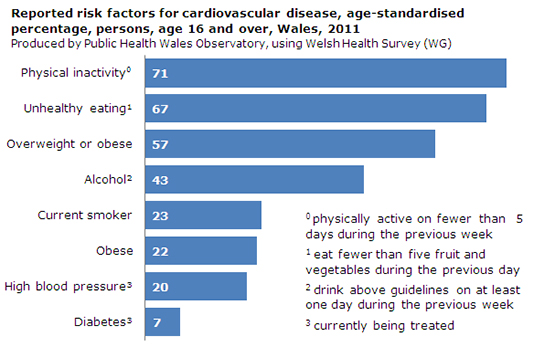
Modifiable risk factors
Hypertension (high blood pressure)
Hypertension is a major risk factor for CVD and is one of the most common causes of premature death worldwide. In 2025, an estimated 1.56 billion adults will be living with hypertension worldwide [2]. Results from the Welsh Health Survey [1] in 2011 reported 20% of adults in Wales being treated for hypertension; a slight increase since the survey started in 2003/04. The percentage of patients with hypertension on the GP register is much lower with around 11% but the methodology is very different and so these measures are not comparable. For details of the methodology please see the technical guide.
Hypertension is called the “silent killer" because it often has no warning signs or symptoms, and many people do not realise they have it. Early detection of hypertension and treatment to reduce cardiovascular risk in people with hypertension is vital for the prevention of coronary heart disease and stroke. Lifestyle changes – particularly weight loss, an increase in physical activity, and a reduction in salt and alcohol consumption – and drug treatment can effectively reduce hypertension [3]. Further information can be found in: Sub-local authority analysis of the Welsh Health Survey (Observatory), Raised blood pressure (WHO).
Raised cholesterol
Raised cholesterol increases the risk of heart disease and stroke and is a major cause of disease burden in both the developed and developing world. In 2008, the global prevalence of raised total cholesterol among adults was 39% (37% for males; 40% for females)[4]. Lowering raised serum cholesterol levels reduces the risk of CVD. A 10% reduction in serum cholesterol in 40 year old men has been reported to result in a 50% reduction in heart disease within five years[5]. Further information can be found in: Raised cholesterol (WHO).
Diabetes
Diabetes not only substantially increases the risk of CVD but also magnifies the effect of other risk factors for CVD such as raised cholesterol levels, raised blood pressure, smoking and obesity[3]. Patients with diabetes also have a poorer prognosis after cardiovascular events compared to people without diabetes. In 2011, the number of adults being treated for diabetes in Wales was 7% [1]. Modelled estimates for Wales arrived at around 9% for 2010 including those that are as yet undiagnosed. Further information can be found in: Sub-local authority analysis of the Welsh Health Survey (Observatory), Diabetes (Health in Wales).
Tobacco use
Tobacco use is a major contributor to the risk of CVD and remains a significant public health issue, causing nearly 10% of CVD worldwide[4]. The risk of developing smoking-related diseases increases with how long and how much someone has smoked. These risks fall substantially if smoking is stopped, even for long-term smokers.
A report entitled Tobacco and health in Wales 2012[7] highlighted that almost one in four adults smoked in 2010 and although smoking has declined in Wales since the 1970s, the rate of decline has slowed down in recent years. This suggests that around 570,000 adults in Wales smoke[7]. Further information can be found in: Smoking (Health in Wales), Tobacco control (Public Health Wales).
Physical inactivity, unhealthy diet and obesity
The rising trend of overweight and obesity has largely been attributed to unhealthy dietary habits, lack of physical activity and sedentary lifestyles. Obesity is strongly related to major cardiovascular risk factors such as raised blood pressure and type 2 diabetes[5].
Being physically active lowers the risk of developing CVD as regular exercise can reduce the risk of coronary heart disease by about 30%[7]. In Wales, around 29% of adults reported doing at least 30 minutes of at least moderate intensity physical activity on five or more days in the previous week[1]. Eating at least five servings of fruit and vegetables a day, and limiting salt intake, also helps to prevent heart disease and stroke. Approximately one third of adults in Wales eat five or more portions of fruit and vegetables a day[1]. Further information can be found in: Profiles of Lifestyle and Health, (Observatory), Physical Activity and Nutrition Networks Wales (Public Health Wales).
Alcohol misuse
Excessive alcohol intake has been associated with an elevated risk of adverse health outcomes, including coronary heart disease, diabetes, hypertension and stroke. Around 43% of adults in Wales reported drinking above the guidelines on at least one day in the past week in 2011[1]. Further information can be found in: Profiles of Lifestyle and Health(Observatory).
Non-modifiable risk factors
Some risk factors associated with CVD cannot be controlled. CVD becomes increasingly common with advancing age, with the risk of stroke doubling every decade after 55 years old[8]. Men are at greater risk of heart disease than pre-menopausal women; however, once past the menopause, a woman’s risk is similar to a man’s[8].
A family’s history of CVD can also indicate a person’s risk. If a first-degree blood relative has had coronary heart disease or stroke before the age of 55 years (for a male relative) or 65 years (for a female relative), the risk increases[8]. Populations in more deprived areas also have a higher risk of CVD than those in less deprived areas[4]. Wales data patterns for mortality from CVD by age and socio-economic status are shown on the Wales data section.
References
[2] World Health Organization Regional Office for South East Asia. Hypertension. [Online]. Geneva: WHO; 2011.
[3] Nichols M et al. European cardiovascular disease statistics 2012. 4th ed. Brussels: European Heart Network, European Society of Cardiology; 2012.
[4] Mendis S, Puska P, Norrving B eds. Global atlas on cardiovascular disease prevention and control. Geneva: WHO; 2011.
[5] Alwan A. Global status report on noncommunicable diseases 2010. Geneva: WHO; 2011.
[6] World Health Organization. Global health risks: mortality and burden of disease attributable to selected major risks. Geneva: WHO; 2009.
[7] Public Health Wales Observatory, Welsh Government. Tobacco and health in Wales. Cardiff: Public Health Wales Observatory; 2012.
[8] World Heart Federation. Cardiovascular disease risk factors. [Online]. Geneva: WHO; 2012.
Explore Data Further
Wales data
Cardiovascular disease (CVD*) is a major cause of ill-health and death in Wales. It is caused by disorders of the heart and blood vessels, and includes coronary heart disease (heart attacks), cerebrovascular disease (stroke), raised blood pressure (hypertension), and heart failure. CVD has a substantial impact on the health service. Over 7% of all inpatient hospital admissions in Wales are for CVD*. There were nearly 33,000 emergency admissions for CVD in 2011/12, around 9% of all emergency admissions. The chart below shows the number of emergency admissions by primary condition. Around a third of these admissions for CVD are for coronary heart disease (CHD) and another third for other forms of heart disease.
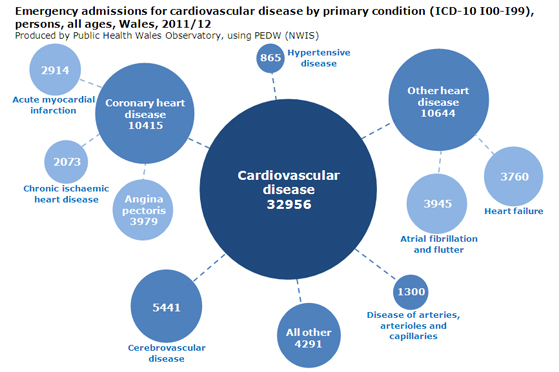
CVD causes around 30% of all deaths in Wales. The chart below shows the breakdown of the number of deaths by cause. The largest single cause is coronary heart disease with over 4,000 deaths in 2011, followed by cerebrovascular disease with over 2,000 deaths. There were also around 300 deaths from hypertensive diseases.
Mortality rates from CVD have steadily decreased over previous years. From 2011 onwards the ICD-10 coding rules for deaths have changed and as a result the number of deaths are around 5% lower than they would have been under the old coding rules. This needs to be taken into account when interpreting the trend data in particular. For the rate calculation in the CVD indicators an adjustment has been made - please see the technical guide for further details.
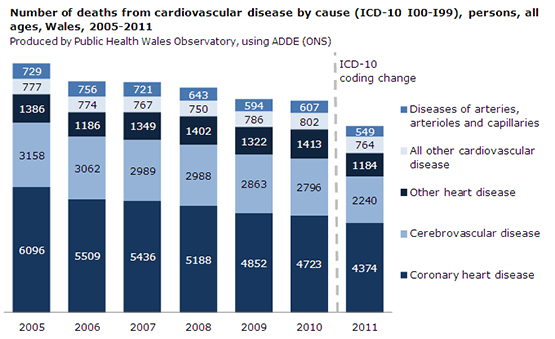
CVD is strongly related to age. The chart below shows the percentage of patients with coronary heart disease (CHD) on the GP registers in Wales. The percentage increases substantially with age for both sexes. It is highest in those aged 85 and over with around 29% in males and 20% in females. The proportion is much higher in males than in females for all age groups.

CVD is related to deprivation. The chart below shows increasing mortality rates aged under 75 with increasing deprivation. The rate in the most deprived areas in Wales is more than twice the rate in the least deprived. This pattern is similar for the UK although the gradient tends to be steeper for Wales. This association with deprivation can be partly explained by the fact that those in low socio-economic positions have a poorer risk factor profile, including greater levels of hypertension and diabetes and a trend towards higher rates of smoking compared to those in higher socio-economic positions[1].
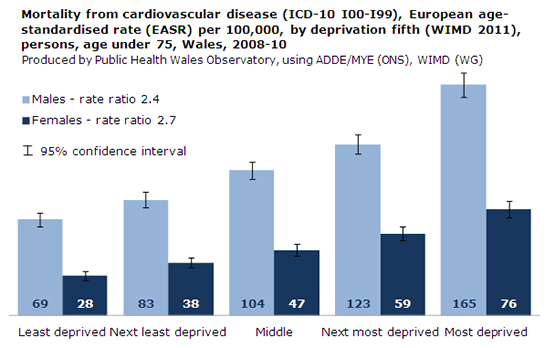
* Where CVD is stated in relation to mortality or hospital admissions we are referring to the ICD-10 chapter on circulatory disease. For details of the definitions used please see the technical guide.
References
[1] Mendis S, Puska P, Norrving B, editors. Global Atlas on cardiovascular disease prevention and control. Geneva:World Health Organisation; 2011.
Due to changes on the host site, this link no longer functions
International data
Each year cardiovascular disease (CVD) causes over 4 million deaths in Europe for all ages, which accounts for 47% of all deaths (see European Cardiovascular Disease Statistics 2012)[1]. In people aged under 75, cardiovascular disease is the main cause of death in Europe and accounts for approximately 1.5 million deaths each year[1].
Mortality rates from cardiovascular disease in those aged under 75 have fallen in most European countries in recent years[1]. The trend chart below shows the mortality rate for 1996 to 2010 in Wales, England, the United Kingdom and selected European countries. It shows that the mortality rate in Wales has more than halved during the period.
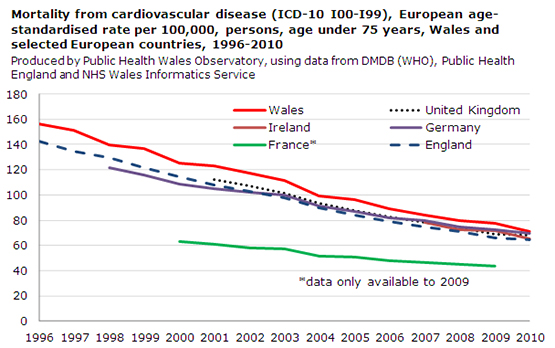
The chart below shows the ranked mortality rates from cardiovascular disease for those aged under 75 from cardiovascular disease for Wales, England, the United Kingdom and selected western European countries for 2009. Only the mortality rate for Finland is higher than the rate for Wales, whilst the rates are lower for all other Western European countries shown in the chart have lower rates. Eastern European countries generally have much higher mortality rates than Wales and comparable Western European countries but are not included in the chart.
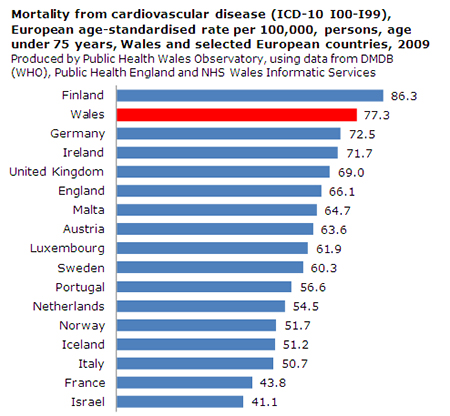
References
Access The Data
Cardiovascular disease indicator
A set of indicators has been developed for this CVD web resource with the following files for download:
 Interactive data file* (.xlsx) containing data for Wales, health boards and local authorities for all 11 indicators (revised on 8/11/2013 to correct the confidence interval display in the health board charts)
Interactive data file* (.xlsx) containing data for Wales, health boards and local authorities for all 11 indicators (revised on 8/11/2013 to correct the confidence interval display in the health board charts)
 Selection of charts* (.pptx) for the 11 indicators in PowerPoint format (revised on 8/11/2013 to correct the confidence interval display in the health board charts)
Selection of charts* (.pptx) for the 11 indicators in PowerPoint format (revised on 8/11/2013 to correct the confidence interval display in the health board charts)
 Seven charts (.pptx) shown on the web pages in PowerPoint format
Seven charts (.pptx) shown on the web pages in PowerPoint format
 Technical guide (.pdf) provides information on the definition of the indicators, the method and data sources used as well as guidance on the interpretation
Technical guide (.pdf) provides information on the definition of the indicators, the method and data sources used as well as guidance on the interpretation
* some of the indicators have been updated in the heart disease delivery plan indicators (see Other Public Health Wales Observatory publications section below)
Other supporting data files
Data files for the Wales level charts shown on the web pages:
 Emergency admissions for CVD by condition (.xlsx)
Emergency admissions for CVD by condition (.xlsx)
 Mortality from CVD by cause and deprivation (.xlsx)
Mortality from CVD by cause and deprivation (.xlsx)
 Percentage with CHD on the GP registers by age group (.xlsx)
Percentage with CHD on the GP registers by age group (.xlsx)
 CVD mortality for Wales and European countries (.xlsx)
CVD mortality for Wales and European countries (.xlsx)
Other Public Health Wales Observatory publications
Health and its determinants in Wales (2018)
The report outlines the picture of health in Wales through 100, mainly graphical, slides. Demography, causes of death and disability, alongside their risk factors, are explored.
Equity of access to revascularisation in Wales by socioeconomic deprivation (2017)
This publication investigates the equity of access to revascularisation by socioeconomic deprivation in Wales. The publication provides evidence that measures to reduce previously observed inequity of access to revascularisation across Wales have been successful.
Smoking data: mortality, hospital admissions & prevalence projection tool (2017)
This publication allows the exploration of smoking-attributable mortality and hospital admissions, and projected smoking prevalence in Wales.
Health and its determinants in Wales - interim report (2017)
The report outlines the picture of health in Wales through 100, mainly graphical, slides. Demography, causes of death and disability, alongside their risk factors, are explored.
General Practice Population Profiles (2016)
Explore levels of lifestyle and social factors, chronic conditions and demographic changes within and between Welsh general practice populations, including peer group comparisons.
Measuring inequalities (2016)
This publication demonstrates the large and persistent inequalities in life expectancy within Wales, echoing the findings of the original "Measuring inequalities" profile published in 2011.
Heart Disease Delivery Plan Indicators (2015)
In April 2015 Powys Local Public Health Team requested a series of indicators showing comparative information across Wales for use in their Heart Disease Delivery Plan Annual Report (2015). Since analysis was produced on an all Wales basis and may have wider utility, the Observatory has packaged this information producing a document for each health board. Many of these indicators are updates of the indicators presented in this topic page:
 Betsi Cadwaladr University Health Board (.docx)
Betsi Cadwaladr University Health Board (.docx)
 Powys Teaching Health Board (.docx)
Powys Teaching Health Board (.docx)
 Hywel Dda University Health Board (.docx)
Hywel Dda University Health Board (.docx)
 Abertawe Bro Morgannwg University Health Board (.docx)
Abertawe Bro Morgannwg University Health Board (.docx)
 Cardiff and Vale University Health Board (.docx)
Cardiff and Vale University Health Board (.docx)
 Cwm Taf University Health Board (.docx)
Cwm Taf University Health Board (.docx)
 Aneurin Bevan University Health Board (.docx)
Aneurin Bevan University Health Board (.docx)
These are not designed as stand-alone documents but as a resource to hold indicators for re-use elsewhere.
 CHD modelled prevalence analysis (2015) (.pdf)
CHD modelled prevalence analysis (2015) (.pdf)
The model estimates GP cluster level CHD prevalence using self reported heart disease data from the Welsh Health Survey and compares it with the QOF CHD register prevalence.
Quality and Outcomes Framework: atrial fibrillation and hypertension (2014)
Information has been published relating to hypertension, stroke and atrial fibrillation from the clinical domains of the quality and outcomes framework (QOF), part of the General Medical Services (GMS) contract.
NHS Expenditure and Health Tool (2013)
This report and interactive tool present NHS expenditure data alongside measures of health and health care. For the circulation problems programme budget this includes a measure related to the prescribing of low acquisition cost lipid modifying drugs.
The GP cluster profiles provide information on a number of key indicators in relation to GP cluster populations. These include CHD, heart failure, hypertension and diabetes for every cluster in Wales.
Measuring Inequalities – Trends in mortality and life expectancy in Wales (2011) - now superseded
This work examines mortality from different causes including circulatory disease between 2001-03 and 2007-09 for males and females. The mortality rate from circulatory disease in the most and least deprived fifths for each local authority and health board is shown together with the rate for Wales as a comparison.
 Equity in the provision of coronary angiography and revascularisation in Wales: NPHS (2009) (.pdf)
Equity in the provision of coronary angiography and revascularisation in Wales: NPHS (2009) (.pdf)
A report examining the provision of key cardiac services in Wales. Rates of coronary angiography and revascularisation are examined in relation to need across Wales. Provision of services is considered by geographical area and level of socio-economic deprivation in Wales, using deaths and emergency hospital admissions from cardiac disease as a proxy for need.
Additional Resources
This page contains links to key data and evidence resources relevant to cardiovascular disease (CVD).
General information on cardiovascular disease and vascular assessment and stroke is available from the Public Health Wales website.
The NHS website ‘Health in Wales’ contains topic pages on cardiac disease, coronary heart disease and stroke. They contain information on what the NHS is doing about these conditions as well as links to Welsh Government strategies, policies and services.
Key data sources
Health Maps Wales
Health Maps Wales is an interactive tool that can be used to explore a variety of health indicators grouped under broad categories. Indicators such as hospital admissions due to CVD, length of stay due to CVD, waiting times for cardiovascular procedures and CVD mortality are available.
Public Health England: 2012 Cardiovascular Disease Profiles for England
These profiles provide a snapshot of key data for England relating to heart disease and stroke, including prevention, incidence, mortality, risk factors and treatment. Many of the indicators provided in the report for England have also been produced with comparable Wales data and included in the cardiovascular disease indicators on the file download page.
Quality and Outcomes Framework (QOF)
This dataset is based on GP practice data. QOF is a voluntary system of financial incentives and it rewards contractors for good practice through participation in an annual quality improvement cycle. The measures include CHD, hypertension and stroke from each GP registered practice and are included in the CVD indicators with further information in the technical guide.
StatsWales
StatsWales is a web-based data resource provided by the Welsh Government. It includes indicators on NHS hospital waiting times for angiography procedures, cardiac revascularisation and cardiac surgery.
Welsh Health Survey
The Welsh Health Survey includes self-reported information about health, health related lifestyle and use of services of people living in Wales. The survey data is available at the local authority level and includes data on heart disease and a range of risk factors which can impact on cardiovascular health e.g. healthy diet, exercising, smoking and high blood pressure.
European Detailed Mortality Database (DMDB)
This database contains mortality data by cause of death, age and sex, submitted to the WHO by European Member States. This database has been used to compare mortality from CVD for Wales and selected European countries (see page on international comparisons)
Key evidence resources
Cardiovascular disease RSS feed
A selective list of additional data and evidence resources for this topic.
2012 European Cardiovascular Disease Statistics
This report, published by the European Society of Cardiology and others, contains the latest key statistics on morbidity and mortality from CVD in European countries including the United Kingdom.
World Health Organisation
The health topics section for ‘cardiovascular diseases’ includes general information, statistics, strategies for prevention and control of CVD and links to other topics related to CVD.
Get in touch
We are always looking to improve on the products we produce to ensure that they are user-friendly. If you have any comments then please get in touch with us by emailing: publichealthwalesobservatory@wales.nhs.uk